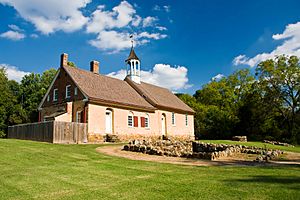Wachovia Tract facts for kids
Wachovia was a special area in what is now Forsyth County, North Carolina, United States. It was settled by a religious group called the Moravians. Out of the six Moravian "villages of the Lord" that were started there in the 1700s, only the town of Bethania and the city of Winston-Salem still exist today within the original Wachovia area. This historic area was a bit bigger than modern-day Winston-Salem but a bit smaller than Forsyth County.
Contents
Exploring Wachovia's Past
The first people who settled in Wachovia were mostly German-speaking. They shared a similar German culture.
How Wachovia Was Chosen
In 1752, a Moravian leader named Bishop August Gottlieb "Brother Joseph" Spangenberg led a trip to find the perfect spot for the Moravians to build their new settlements. Members of the Moravian Church in Europe bought about 98,985 acres (400 square kilometers) of land in the middle-western part of North Carolina. They bought this land from a person named John Carteret, 2nd Earl Granville.
The Name Wachovia: A Special Tribute
The name "Wachovia" is a Latin version of the German name Wachau. It was chosen for the North Carolina Moravian land to honor Count Zinzendorf. He was a very important leader and supporter of the Moravians. His family's estate was in the Wachau region of Austria, near the Danube River. The mountains and rivers in North Carolina reminded the explorers of that beautiful area in Austria.
First Moravian Settlements in Wachovia
In 1753, twelve Moravian men, called "Single Brethren," traveled from Pennsylvania to Wachovia. They started the first settlement, Bethabara, on November 17, 1753. Its name means "House of Passage" in Hebrew, showing it was a temporary home.
Bethabara During Wartime
During the French and Indian War (1754–1763), a wooden fence, called a stockade, was built around Bethabara. It became a safe place for many settlers from the surrounding area. By May 1759, about 120 people found refuge there.
Bethania: The First Planned Town
The first truly planned Moravian settlement was Bethania, started on June 12, 1759. Its name means "house/place of dates and figs" in Hebrew. Bethania was officially recognized as a town in 1995. It is still the only independent Moravian town in the southern United States that has been active continuously. You can visit Historic Bethania today to learn more about its past.
Salem: The Central Moravian Town
Wachovia's main administrative town was Salem. It was started in 1766 and formally organized in 1771. Moravians and their friends from Bethabara and Bethania helped build it. Today, you can visit Salem at Old Salem Museums and Gardens.
Other Moravian Communities
Other Moravian communities were later formed, including Friedberg (1769), Friedland (1772), and Hope (1775). The Hope community was the first Moravian church in the area where English was spoken.
Winston-Salem: A City Grows
In 1849, a new county seat (the main town for the county government) was created north of Salem for the newly formed Forsyth County. This new town was named Winston in 1852. Later, in 1875, the R.J. Reynolds Tobacco Company was founded in Winston. In 1913, the towns of Salem and Winston officially joined together to become Winston-Salem. Today, Bethabara is part of Winston-Salem and can be visited at Historic Bethabara Park.
Wachovia's Changing Borders
Over time, the large Wachovia land area was divided into different counties as more people moved into North Carolina. These counties included:
- Rowan County (1753)
- Surry County (1771)
- Stokes County (1789)
- Forsyth County (1849), which was created from the southern part of Stokes County.
Visiting Wachovia Today: Museums
If you want to step back in time and see what Wachovia was like, you can visit several museums:
These museums help tell the story of the Moravians in North Carolina. They preserve and show what life was like in Wachovia long ago.
Wachovia Corporation: A Bank's Story
The Wachovia area also gave its name to the Wachovia Corporation, which was once one of the biggest banks in the world. This bank was started by I.G. Loesch from Bethania. The bank's main office was in Salem, then Winston-Salem, until it merged with another company called First Union. After that, the main office moved to Charlotte, North Carolina.
Images for kids




